[/caption]
With the Sun’s activity increasing just a bit, sky watchers have witnessed an uptick in aurorae, especially northern observers. This top image is from an *extreme* northern observer, as in way up; about 320 km (220 miles) up above the Earth. Astronaut Doug Wheelock took this image from the International Space Station, and the beautiful sight made him wax poetic:
“Aurora Borealis as I will forever paint it in my dreams,” he wrote on Twitter. “Almost time to return home… no regrets… but mixed emotions. Leonardo da Vinci was right… ‘For once you have tasted flight, you will forever walk the Earth with your eyes turned skyward, for there you have been… and there you will long to return.'”
See other stunning recent aurora images from a more Earthly viewpoint:
These particular aurorae sightings were likely the result of a solar flare that erupted towards Earth on Nov. 12.
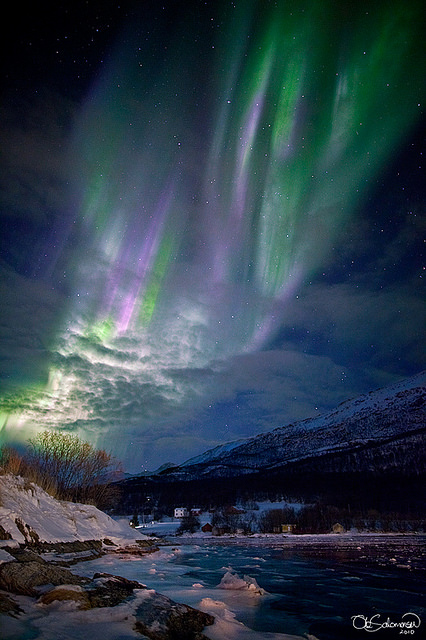
Describing this picture, Salomonsen said on Flickr: “With a CME expected to hit earth on Nov.14th we could still see only a faint aurora. We got frustrated and then decided to drive back towards the city where it now was reported to clear up. After 5 minutes in the car suddenly we could see a strong aurora bursting out behind the partially cloudy sky.”
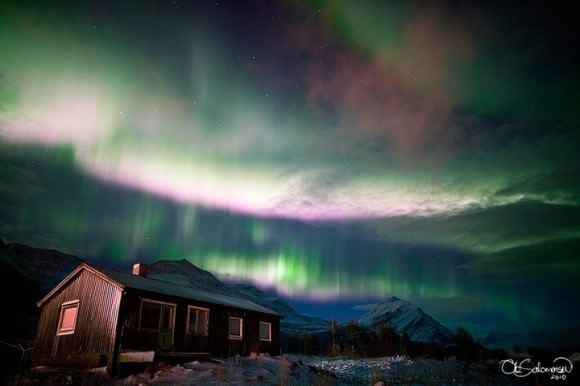
This is another gorgeous shot by Salomonsen, and on his Flickr site, he points out Ursa Major is visible in the top left, said it was just amazing how there were two rays of white and purple aurora, one moving faster than the other.
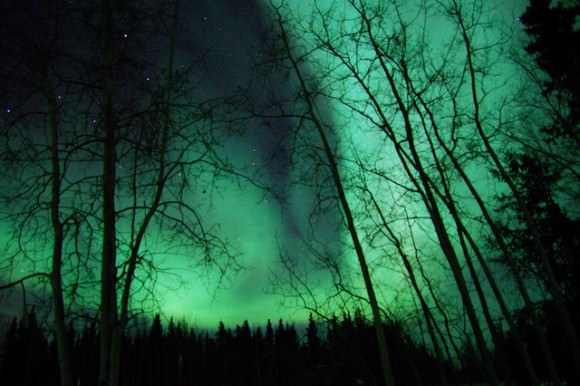
Photographer Sean Davies took this image on Nov. 13, 2010 near Dettah in the Northwest Territories, Canada, and said, “The aurora put on a great show just outside Yellowknife. The show lasted a good hour.” There’s another from Sean, below, on the same night. You can see more of Sean’s images at his Flickr site.
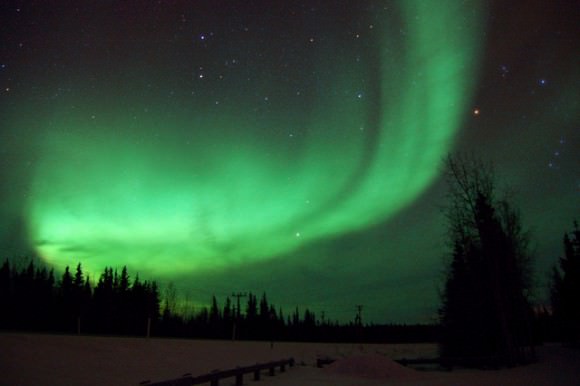
The photo below was taken on November 13, 2010 in Auster-Skaftafellssysla, Iceland by Skarphéðinn Þráinsson. See more of his images at Flickr.
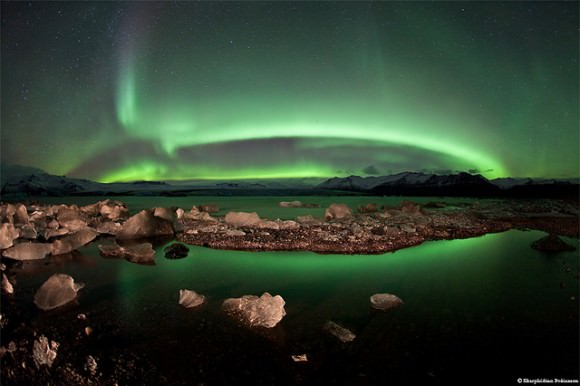
This timelapse video was taken by Tor Even Mathisen, also from Tromsø, Norway.
Aurora Borealis timelapse HD – Tromsø 2010 from Tor Even Mathisen on Vimeo.
*Posted especially for Hon. Salacious B. Crumb

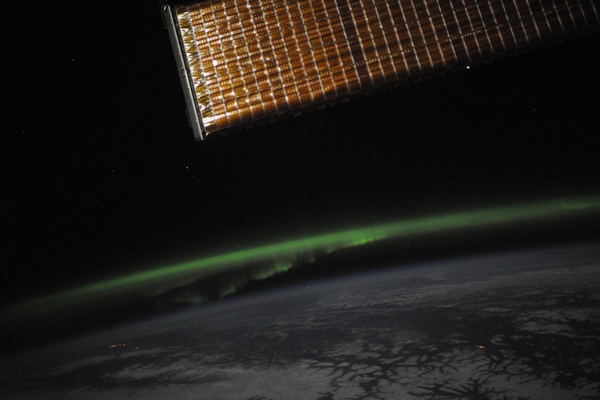
It’s hard for me to decide who got a better view of these recent displays….the view from above or the views from below I find equally mesmerizing. Every year it seems like the skills of these aurora imagers and others improves. Even when presented with amazing auroral displays in the heavens, photographers still must work to find a suitable composition that adds to the beauty of the display and increases the impact of the picture itself. These are some fine examples of the *art* of aurora photography. Thanks for posting these, Nancy.
so Crumb, I guess you owe to Nancy some apologies?
let me quote your statement from two days ago:
“Hon. Salacious B. Crumb
November 17th, 2010 at 10:25 pm
On the 17th/18th November the prediction that little would be observed proved to be true. Like most news stories, the notification is hailed with fanfare, but when the news proved to be wrong or false, the instigators / perpetrators of the sensationalism are gone with the dust! Worst the story falls off the front page, leaving people who read it far more sceptical and more cynical of science and the scientific methods.
I’ve store this in my memory bank, and will drag it out again next time we have a sensational claim.”
For me it seems that not the “instigators” are gone with the dust this time…
@Nancy, thank you for the very nice pictures.
Sorry, I saw only now the foot note of the article 🙂
A moderator can delete my both posts if he/she finds it necessary.
Quasy
Thank for the subtle reminder.
Frankly, I too missed Nancy’s “dedication” the first time I’d read the article. (Positively, at least it is good to see she reads all the comments made to her stories!)
Sorry to say, I have to stand by my responses. I still have doubts that this aurora was mostly related to the CME as said in the previous article. “Aurora Alert! Solar Flare Heading Our Way.” I base on the information via various space weather internet sites, which infer that the aurora seen in Norway, etc. was due to more activity in the solar wind..
Looking at the so-called Planetary K-index between 11th and 17th showed little variation, and only rose to K=4 in that time. Here geomagnetic storms are based on probabilities, that “…are the estimated chances of at least one 3-hour K index, at the indicated level, for each of the next 3 days.” Here storms are classified as; Active: K = 4, Minor storm: K = 5, Major or Severe storm: K > 6., etc.
Also the highest activity observed happened mostly on 14th Nov 15hUT to 15th Nov 01UT, with the largest spikes on 15th Nov 10:13UT and 15th Nov 11:32h UT.
The previous peak happen on 12th around 06h UT (unrelated to the CME event)
As you said in quoting me ; “On the 17th/18th November the prediction that little would be observed proved to be true.”
And so it was It does seems only very high latitudes saw this event.
This last event from the CME 12th November had only a minor effect on the auroral oval, which may or may not have been related to it.
Frankly IMO, the only real auroral alert should be if a significant CME is headed straight for Earth, else it look like “crying wolf” – the heart of my comment.
My response mostly came from original comment by Gherreram, who said;
From the evidence, then and now, what I said was correct For a majority of observers reading these UT aurora stories; “From the info available, it is highly unlikely you’ll see anything.” and “It is quite irresponsible here to call an aurora alert, as the likelihood of the auroral oval reaching the US is quite low.”
Regardless of my opinions here, these aurorae shots are really nice, and I thank Nancy for posting them — whether it was caused by the 12th CME event or not!
Note: If you are wanting to see the auroral oval (the place where you would have the chance of see an aurora, I suggest you go to NOAA POES page at http://www.swpc.noaa.gov/pmap/. Here you can see an animated movie of the fluctuations of the auroral oval over the last 24 hours or so by selecting from the side menu “Northern Hemi Movie” or “Southern Hemi Movie.” Clicking it sees the evolution of the auroral oval, which ‘pulses’ every now and then. Under normal conditions the oval is small (about 22 degrees in radius), but during CME events colliding with the Earth field (or during magnetic storms) the auroral oval expands in its diameter; I.e. Sometimes falling over the US or southern New Zealand.
@ Quasy
You also left my other statement too…
I think Nancy was responding to this comment and not the one you quoted at me earlier?
Note: No need to worry if your statements ought to be moderated. Balanced criticism should be promoted as it promote useful conversation! In my view, your rebuke of me is well deserved!
Is that camera flash bouncing off the solar panel in the first image? Seriously, astronaut Doug Wheelock? I hate to be the one to have to explain this to you, but you probably just want to turn off your flash when photographing things 10,000 miles away.
@Beebop: I think that’s actually just reflection from the station or sunlight itself. If the flash went of, I think we wouldn’t see the Earth.
Beautiful pictures and nice video, Nancy 🙂
I forwarded this article to a few science skeptic friends who say that knowing too much about nature detracts from appreciating its beauty, because you can know a CME from the Sun probably caused these light shows, but it can’t stop you from being mesmerized by its effect in the sky.